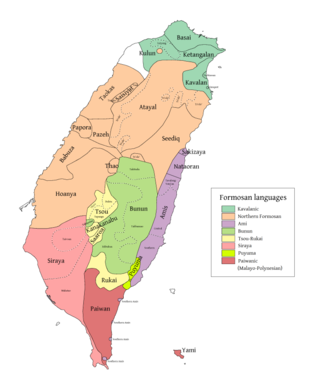Top Qs
Timeline
Chat
Perspective
Kanakanavu language
Austronesian language spoken in Taiwan From Wikipedia, the free encyclopedia
Remove ads
Kanakanavu (also spelled Kanakanabu) is a Southern Tsouic language spoken by the Kanakanavu people, an indigenous people of Taiwan (see Taiwanese aborigines). It is a Formosan language of the Austronesian family.
You can help expand this article with text translated from the corresponding article in Chinese. (January 2013) Click [show] for important translation instructions.
|
The Kanakanavu live in the two villages of Manga and Takanua in Namasia District (formerly Sanmin Township), Kaohsiung.[2]
The language is moribund, with only 4 speakers (2012 census).[3]
Remove ads
History
The native Kanakanavu speakers were Taiwanese aboriginals living on the islands. Following the Dutch Colonial Period in the 17th century, Han-Chinese immigration began to dominate the islands population. The village of Takanua is a village assembled by Japanese rulers to relocate various aboriginal groups in order to establish easier dominion over these groups.[4]
Phonology
There are 14 different consonant phonemes, containing only voiceless plosives within Kanakanavu. Adequate descriptions of liquid consonants become a challenge within Kanakanavu. It also contains 6 vowels; phonetic diphthongs and triphthongs occur where vowels are adjacent. Vowel length is often not clear if distinctive or not, as well as speakers pronouncing vowel phonemes with variance. As most Austronesian and Formosan languages, Kanakanavu has a CV syllable structure (where C = consonant, V = vowel). Very few, even simple words, contain less than three to four syllables.[5]
Consonants
/s/ is pronounced [ʃ] before /i/ and /t͜s/ is pronounced [t͜ʃ] before /i/ and /ʉ/.[5]
Vowels
Remove ads
Orthography
Several texts have been transcribed by outsiders in the orthography of the Council of Indigenous Peoples of Taiwan, and a dictionary is available. ⟨C⟩ is used for /t͜s/, ⟨ng⟩ for /ŋ/, ⟨r⟩ and ⟨l⟩ for /ɾ/ and /ɽ/, ⟨ꞌ⟩ for /ʔ/, and ⟨ʉ⟩ for the central vowel.
References
Further reading
External links
Wikiwand - on
Seamless Wikipedia browsing. On steroids.
Remove ads


